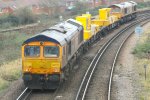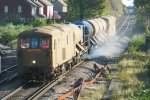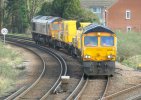I think that is the normal formation for a Snow and Ice Treatment Train (SITT), with two "remote control" wagons.
In your
screenshot from flickr, the back tank (small square-shaped thing) is labelled "fuel filler" and the front tank is labelled "de-icing fluid filler." The caption mentions the "motor on it chugging away" which means the nearest tall module is probably a diesel generator (appears to have a little black vent coming out of it). The other tall module probably has pumps and other control machinery in it.
The writing on a de-icing tank is visible more clearly in this photo (zoom in, on the left):
https://www.flickr.com/photos/tigertim1950/24953799186/
They would only need to apply a thin film of de-icing fluid, unlike the high-pressure jet of water from an RHTT, so the tanks are a lot smaller (the sandite module on an RHTT is also a sort of box).
There's a Network Rail page which mentions these trains:
https://www.networkrail.co.uk/runni...al-track-treatment-and-weather-support-fleet/
The MPV and SITT both scrape ice off the conductor rail head (the top of the conductor rail) and can spray the rails with hot liquid anti-icer that prevents ice sticking to the conductor rail head.
I assume the SITTs work similarly to the autumn railhead treatment trains (RHTTs), with a dedicated operator in the cab turning the flow of de-icing fluid on and off or switching it from one side to the other to match the location of the conductor rail in different places.
In this shot of an RHTT, the wagon appears to be connected up to a jumper cable on the loco. I don't think this is being used for multiple-working of the locos; as I understand it the cable is being used as part of the control system operating the sandite equipment and water tanks (although I could be wrong).
https://www.flickr.com/photos/the_prisoner/51647847801/
From the photos I've seen, I don't think this arrangement is used on the SITTs, so perhaps the "remote control wagon" is literally that - operated by remote control from the operator's handset, or maybe a laptop, connected wirelessly.
I'm making a few assumptions here, so maybe someone can clarify or correct the technical details.






